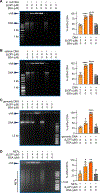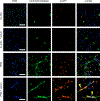Interaction of the antiphospholipid syndrome autoantigen beta-2 glycoprotein I with DNA and neutrophil extracellular traps
- PMID: 37527733
- PMCID: PMC11200149
- DOI: 10.1016/j.clim.2023.109714
Interaction of the antiphospholipid syndrome autoantigen beta-2 glycoprotein I with DNA and neutrophil extracellular traps
Abstract
Beta-2 glycoprotein I (β2GPI) is a phospholipid-binding plasma protein and prominent autoantigen in antiphospholipid syndrome (APS). Here, we tested the hypothesis that β2GPI might bind to not only phospholipids, but also cell-free DNA and neutrophil extracellular traps (NETs). We report that β2GPI interacts with cell-free DNA from different species, as well as NETs, in a dose-dependent manner, retarding their migration in an agarose-gel electrophoretic mobility shift assay. We confirm the direct binding interaction of β2GPI with DNA and NETs by ELISA. We also demonstrate that β2GPI colocalizes with NET strands by immunofluorescence microscopy. Finally, we provide evidence that β2GPI-DNA complexes can be detected in the plasma of APS patients, where they positively correlate with an established biomarker of NET remnants. Taken together, our findings indicate that β2GPI interacts with DNA and NETs, and suggest that this interaction may play a role as a perpetuator and/or instigator of autoimmunity in APS.
Keywords: Antiphospholipid antibodies; Antiphospholipid syndrome; DNA; Lupus; Neutrophil extracellular traps; beta-2 glycoprotein I.
Copyright © 2023 Elsevier Inc. All rights reserved.
Conflict of interest statement
Declaration of Competing Interest None of the authors has any financial conflict of interest to disclose.
Figures




References
-
- Miyakis S, Lockshin MD, Atsumi T, Branch DW, Brey RL, Cervera R, Derksen RH, PG DEG, Koike T, Meroni PL, Reber G, Shoenfeld Y, Tincani A, Vlachoyiannopoulos PG, Krilis SA, International consensus statement on an update of the classification criteria for definite antiphospholipid syndrome (APS), J Thromb Haemost, 4 (2006) 295–306. - PubMed
-
- Knight JS, Branch DW, Ortel TL, Antiphospholipid syndrome: advances in diagnosis, pathogenesis, and management, BMJ, 380 (2023) e069717. - PubMed
-
- Miyakis S, Giannakopoulos B, Krilis SA, Beta 2 glycoprotein I--function in health and disease, Thromb Res, 114 (2004) 335–346. - PubMed
-
- de Groot PG, Meijers JC, beta(2) -Glycoprotein I: evolution, structure and function, J Thromb Haemost, 9 (2011) 1275–1284. - PubMed
Publication types
MeSH terms
Substances
Grants and funding
LinkOut - more resources
Full Text Sources
Miscellaneous

